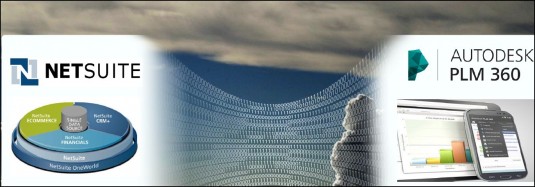The goal is increased visibility of all product data, from materials to availability and inventory, in one dashboard environment for everyone in the organization.
Autodesk and NetSuite have started a strategic partnership to link their two cloud-based technologies, Autodesk PLM 360 and NetSuite ERP. The alliance creates a unique set of tools to span the separate disciplines of Product Lifecycle Management and Enterprise Resource Planning.

The integration of the two products is bi-directional, meaning data created in either Autodesk PLM 360 or various NetSuite products including NetSuite Manufacturing Edition can be linked to processes in the other vendor’s product.
PLM software doesn’t manage financials or inventory management; ERP software doesn’t handle Bill of Materials, Engineering Change orders, environmental compliance, or other functions found in PLM. Putting both together gives both vendors an opportunity to create a single closed-loop solution for product design and development by providing increased visibility into product data across the manufacturing organization.
Two uses cases highlight the possibilities for using both products in tandem:
Create new vendor: Many companies have a standard process for adding a new vendor to a manufacturing project. Once approved, data on the new vendor can be added to PLM 360 in relation to their product’s role in the final product. Entering the new vendor in PLM 360 automatically generates a similar entry in NetSuite; when the vendor is approved by 360’s audit cycle, the vendor is triggered as active in NetSuite. All transactions with the vendor (receivable, inventory, etc.) are now active and tracked in both products. Having the data active and linked in both products gives needed visibility to both the manufacturing side and operations/accounting. Engineers now have access to cost data that could influence product decisions.
Create Engineering Change Order: When an Engineering Change Order is opened, it affects both the engineering Bill of Materials and the manufacturing Bill of Materials. By linking the ERP, cost impact can be assessed early in the manufacturing planning process.
Our take
Market research shows that manufacturers are increasingly turning to cloud-based Software-as-a-Service (SaaS) applications to run product development, production, supply chain, order management, financials and other core business applications without the time and cost burden of on-premise software and servers. Research firm Gartner predicts 47% of manufacturers worldwide will be using or piloting Software as a Service (cloud-based or SaaS) applications by 2015, up from just 2% in 2010.
NetSuite is the leading provider of cloud-based ERP applications, and Autodesk is making waves with its new cloud-based PLM. By coming together and providing a dashboard service that shows not only the size, shape, and technical data for a widget but its costs, availability, and environmental “weight,” everyone in the organization can have access to the same information at the same time, without the traditional need to wait for somebody to send a report.
Cloud technologies are being rapidly adopted in virtually every software category because they provide utility not previously available. In this case, two heads are definitely better than one; the Autodesk PLM 360 head and the NetSuite ERP head can share their thoughts for the enlightenment of their human masters in one place at one time.





